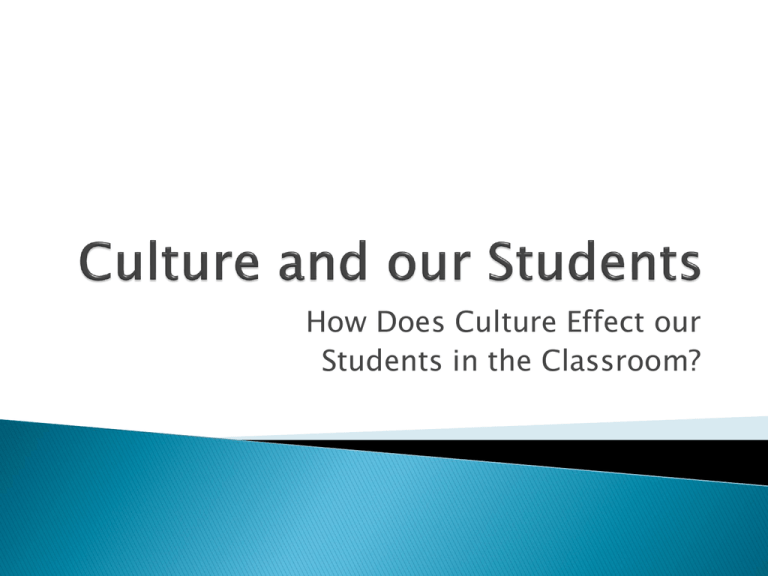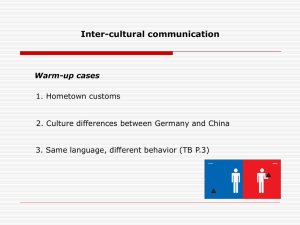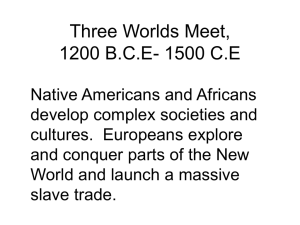Culture and our Students
advertisement

How Does Culture Effect our Students in the Classroom? It’s important to know what culture is before you can understand how it effects our students. There are many different definitions of culture. My definition: ◦ Culture is a way of identifying groups of people through common identities – such as customs, language, holidays, religions, institutions, common beliefs, interactions with others, behaviors, etc. Culture defines all of us. According to Crochunis, T., Erdey, S., & Swedlow, J. (2002), human development and schooling are directly influenced by culture and its values. We all develop our identity from the culture we grow up in. You may have asked yourself these questions when you were a student. Our students ask these questions everyday: ◦ ◦ ◦ ◦ ◦ Where do I fit in at school? What’s my role in my family? How do I balance home life and school life? What is success? How do I succeed? How we use our language is largely dependent on our culture (Crochunis et al, 2002). ◦ ◦ ◦ ◦ What are the goals of speaking? When should I speak? Whom do I speak to? In which circumstances is speaking appropriate? My culture is important to me – as a student, as a teacher, and as a part of the community. ◦ That means the culture of others – students and teachers – are just as important to them and should be recognized. ◦ If I (the student) see myself as a valued part of the class, then what I have to say is worthwhile and my opinion will be listened to and not mocked. This leads to feeling more self-worth, higher selfesteem, and more interaction in class. Self-fulfilling prophecy (Crochunis et al, 2002). ◦ If a teacher believes that the student cannot learn lives up to the lowered expectations of the teacher ◦ If a teacher believes that the student can learn – and learn well, the student will live up to the higher expectations We all learn in different ways. When my type of learning is used, I can excel with that topic when compared to others in the classroom (from my own personal experience and my observations in the classroom). Cultural Deficit Theory (Crochunis et al, 2002). Some students can’t achieve because of their culture, ethnicity, language or race. Teachers can see students from minorities as unable to learn/keep up with the rest of the class. ◦ This leads back to the self-fulfilling prophecy Understand that the language a child brings to school is valuable to that child’s home (Delpit 2006). Self-fulfilling prophecy (Crochunis et al, 2002). ◦ I have seen this at work – with myself when I was a student in middle/high school and with my students. ◦ When there are higher expectations, the student knows that the teacher believes in him/her and will live up to those expectations. ◦ When those expectations are lowered, the student sees him/herself as less worthy and will sink to the levels of the lowered expectations. Choices – some students may not be allowed to make many choices in their schooling (like choosing class electives) (Helmer, S. & Eddy, C. 2003). Parent involvement – the dominant American culture wants parents to be involved in their child’s education (Helmer et al. 2003). ◦ Many cultures believe that the teacher is the expert and does not need parental help ◦ Many parents support teachers – in differing ways The following are issues that I have experienced/seen taking place in the classrooms of my colleagues, the hallways of the school, and my own classroom. Eye contact ◦ some cultures believe that eye contact with an adult is disrespectful Proximity ◦ some cultures value individual space ◦ other cultures value closeness (Darn 2005). Play ◦ some cultures value play as a learning experience ◦ some cultures see play as a waste of school time – the student is there to learn Teacher prejudices – we are used to our own culture. We tend to judge other cultures/students based on OUR culture – not theirs. Stereotyping Discrimination/Racism Dialects ◦ My own English dialect tends to be different from that of my students because I am from a different state than most of my students. ◦ This leads to some confusion when I use a phrase or term that is common to my community but rarely used in my students’ communities. Cooperative Learning ◦ Some students don’t know how to work well in group ◦ While still other students may not know how to work well on their own Crochunis, T., Erdey, S., & Swedlow, J. (2002). The diversity kit. Education Alliance: Brown University Darn, S. (2005, February) Aspects of nonverbal communication. Retrieved from http://iteslj.org/Articles/Darn-Nonverbal/ Delpit, L. (2006) Other people’s children: cultural conflict in the classroom. New York: New Press Helmer, S. & Eddy, C. (2003). Look at me when I talk to you: ESL learners in non-ESL classrooms. Don Mills, Ontario: Pippin.











